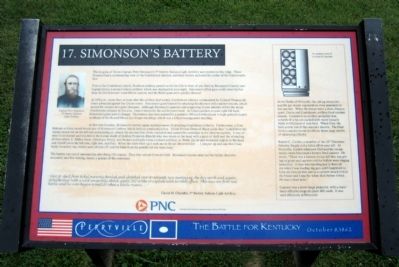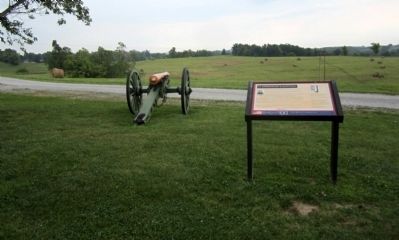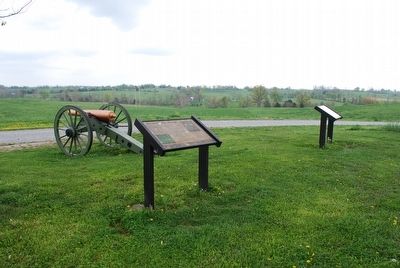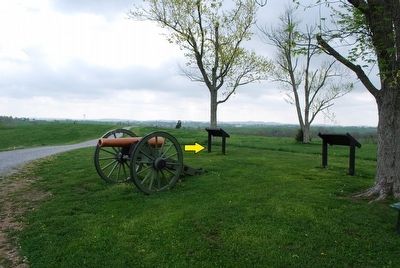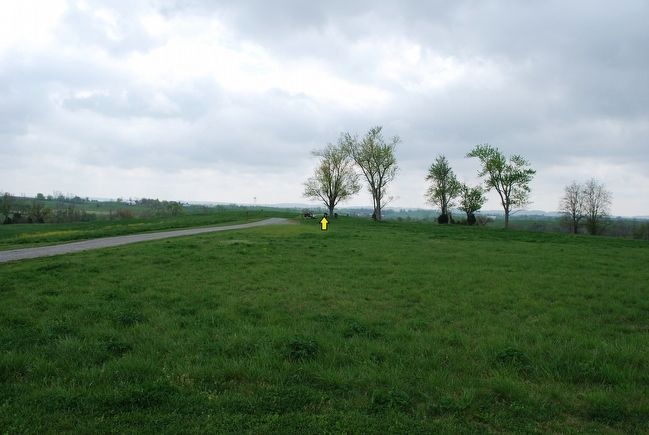Perryville in Boyle County, Kentucky — The American South (East South Central)
Simonsonís Battery
Perryville ē The Battle For Kentucky
ó October 8, 1862 ó
Prior to the Confederate attack, Southern artillery posted on the far hills in front of you fired on Simonsonís battery and Captain Cyrus Loomisís Union artillery, which was deployed to your right. Simonsonís rifled guns could shoot farther than the Confederatesí smoothbore cannon, and the Rebel guns were quickly silenced.
At 3:00 pm., more than an hour after the artillery duel ended, Confederate infantry commanded by Colonel Thomas M. Jones advanced against the Union center. Simonsonís guns blasted the attacking Southerners with canister rounds, which turned the cannon into giant shotguns. Although Simonsonís gunners and supporting Union infantry stifled the initial Confederate advance in this area, Jonesís troops hit the artillerymen hard. As Union soldiers to your right fell back, Simonsonís guns were in danger. The battery was then ordered to a position 300 yards behind you to high ground located southeast of the Russell House (no longer standing), which was a Union headquarters building.
At that new location, Simonsoní battery again endured waves of attacking Confederate infantry. Furthermore, a Confederate artillery round struck one of Simonsonís limbers, which held an ammunition box. Union Private Ormond Hupp wrote that “a shell from the enemy struck me on the left arm and passing on, struck the ammunition chest, exploded and caused the cartridges in the chest to explode. It was all done in an instant and resulted in the instant death of [soldier Frederick Ehrich] who was struck in the head with a piece of shell and the wounding of four others, C. Miller, burnt, [Abraham Forry], arm broken and badly burnt on head and face; A. Pettit, lip cut and wounded slightly in the head and myself cut in the left arm, right arm, and face. When the chest blew up it took me in the air about ten feetÖI jumped up and saw that I was badly wounded, my clothes were all torn off, and the burn from the powder set me near crazy.”
The battery ran out of ammunition after firing 755 rounds. They then retired from the field. Simonsonís ninety men lost two killed, fourteen wounded, and five missing, nearly a quarter of the command.
“Shot & shell from Rebel Batteries howled and shrieked over & around, now tearing up the dry earth and again Ďricochetingí with a wild unearthly shriek again [to] strike or explode with terrible effect. This was our first real battle and we soon began to realize what a battle meansÖ”
Daniel H. Chandler, 5th Battery, Indiana Light Artillery
(sidebar)
At the Battle of Perryville, the rolling terrain frequently put enemy regiments in close proximity to one another. When the troops were a short distance apart, Union and Confederate artillery fired canister rounds. Canister is an artillery projectile that consists of a tin can packed with many (usually thirty to fifty) lead or iron balls. When fired, the balls scatter out of the cannonís muzzle. The blast from a canister round would cut down large swaths of advancing infantry.
Robert C. Carden, a member of the 16th Tennessee Infantry, fought in the fields off to your left. At Perryville, Carden witnessed firsthand the savage results when Simonsonís battery fired canister. He wrote, “There was a battery on our left that was giving us grape and canister and the bullets were singing around us. A man was standing just in front of me while I was loading my gun and I happened to have my eyes on him just as a canister struck him in the breast and I saw the white flesh before it bled. He was a dead man.”
Canister was a short-range projectile, with a maximum effective range of about 400 yards. It was used effectively at Perryville.
(captions)
Captain Peter Simonson, 5th Battery, Indiana Light Artillery.
A cutaway view of a round of canister.
Erected by PNC Bank. (Marker Number 16.)
Topics. This historical marker is listed in this topic list: War, US Civil. A significant historical date for this entry is October 8, 1862.
Location. 37° 40.084′ N, 84° 58.339′ W. Marker is in Perryville, Kentucky, in Boyle County. Marker can be reached from Park Road west of Battlefield Road (Kentucky Route 1920). Located in Perryville Battlefield State Historic Site. Located at Interpretive Marker 16 on the Perryville Battlefield Trail System (Jones Trail). Touch for map. Marker is at or near this postal address: 1825 Battlefield Road, Perryville KY 40468, United States of America. Touch for directions.
Other nearby markers. At least 8 other markers are within walking distance of this marker. Defense of Loomisí Heights (a few steps from this marker); ďFor Godís Sake, Save That BatteryĒ The 38th Indiana at Perryville (about 400 feet away, measured in a direct line); Artillery Duel at Loomis Heights (about 400 feet away); Michigan at Perryville (about 700 feet away); Assault From The Bottom House (about 700 feet away); Assault from the Bottom House (about 700 feet away); The 15th Kentucky Infantry (US) (about 700 feet away); Baptism of Fire (approx. 0.2 miles away). Touch for a list and map of all markers in Perryville.
Credits. This page was last revised on November 3, 2021. It was originally submitted on August 25, 2011, by Bernard Fisher of Richmond, Virginia. This page has been viewed 1,037 times since then and 29 times this year. Last updated on March 6, 2021, by Bradley Owen of Morgantown, West Virginia. Photos: 1, 2. submitted on August 25, 2011, by Bernard Fisher of Richmond, Virginia. 3, 4, 5. submitted on September 14, 2015, by Brandon Fletcher of Chattanooga, Tennessee.
